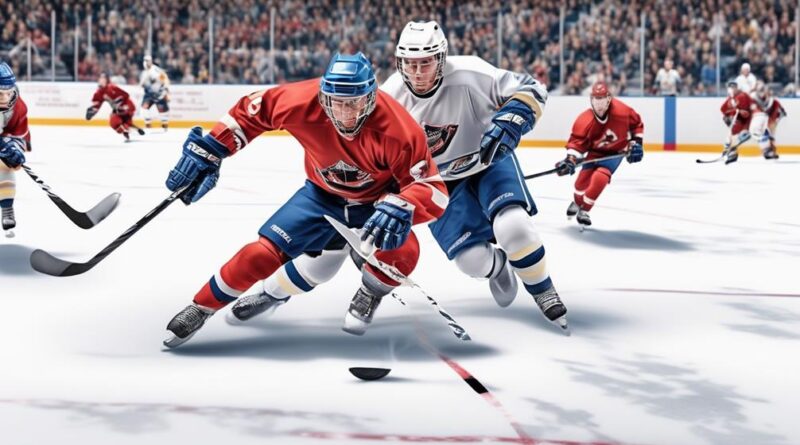Why Is Forechecking Essential in Hockey Coaching Strategies?
You may not realize it, but forechecking is the unsung hero of successful hockey coaching strategies. It's not just about putting pressure on the opposing team's defense; it's a strategic approach that can dictate the flow of the game and create scoring opportunities for your team.
Imagine being able to disrupt your opponents' breakout, force turnovers, and control the pace of play—all through effective forechecking. The impact of this essential strategy extends far beyond the defensive zone, and understanding its intricacies is crucial for any coach looking to elevate their team's performance on the ice.
Importance of Forechecking in Hockey Coaching
Mastering the art of forechecking is crucial for hockey coaches seeking to create pressure and disrupt the opposing team's offensive flow. Forechecking techniques and player positioning are essential aspects in achieving this objective. As a coach, it's important to instill in your players the significance of offensive pressure and defensive responsibilities when implementing forechecking strategies.
Forechecking techniques involve employing aggressive tactics to regain possession of the puck in the opponent's zone. This requires players to anticipate the movements of the opposing team, apply pressure, and force turnovers. As a coach, you must emphasize the importance of player positioning during forechecking. Players need to maintain proper spacing to limit the opponent's passing options while being ready to apply pressure when the opportunity arises.
Creating offensive pressure through effective forechecking not only disrupts the opposing team's flow but also provides scoring opportunities for your team. By pressuring the opposing defensemen and forcing turnovers, your team can regain possession in the offensive zone and launch immediate attacks, catching the opposing team off guard. However, it's crucial to balance offensive pressure with defensive responsibilities. Players must be mindful of their positioning to prevent being caught out of position in case the opposing team breaks through the forecheck.
Key Principles for Effective Forechecking
To effectively implement the importance of offensive pressure and defensive responsibilities instilled in your players during forechecking, it's essential to understand the key principles for effective forechecking. By incorporating these principles into your coaching strategy, you can maximize your team's chances of winning possession and creating scoring opportunities.
- Effective Positioning: Encourage your players to maintain proper positioning on the ice during forechecking. This includes maintaining a staggered formation to cut off passing lanes and limit the opposition's options. Emphasize the importance of reading the play and anticipating the movements of the opposing team to position themselves effectively.
- Aggressive Pressure: Instill in your players the importance of applying aggressive pressure on the puck carrier and the supporting players. This aggressive approach can disrupt the opposing team's breakout, leading to turnovers and scoring chances for your team. Emphasize the need for quick and decisive action to apply pressure effectively.
- Quick Transition: Teach your players the importance of a quick transition from forechecking to defensive coverage. Once the puck is turned over, players should be prepared to quickly adjust their positioning and responsibilities to prevent the opposition from regaining control and counterattacking.
Tactical Approaches for Forechecking Success
Encourage your team to consistently apply tactical approaches for forechecking success to maintain pressure and create scoring opportunities. Effective forechecking positioning is crucial for disrupting the opponent's breakout and creating turnovers.
One tactical approach is the 1-2-2 forechecking system, where one forward pressures the puck carrier, two forwards support in the middle to cut off passing lanes, and two defensemen hold the blue line to prevent easy exits. This system allows your team to maintain offensive pressure while minimizing the risk of being caught out of position.
Another tactical approach is the aggressive 'swarm' forechecking, where all forwards aggressively pressure the puck carrier and any nearby opponents. This approach can overwhelm the opposition and force turnovers in the offensive zone, leading to quick scoring opportunities. However, it requires disciplined positioning and communication to prevent leaving gaps in the defensive coverage.
Encouraging your players to read the play and make quick decisions is essential for successful forechecking. Teaching them to recognize when to press aggressively and when to fall back into a more conservative position can disrupt the opponent's rhythm and lead to scoring chances.
Incorporating tactical approaches for forechecking success not only creates offensive pressure but also energizes your team by keeping them actively engaged in the game. By consistently applying these tactics, your team can maintain control of the game and increase their scoring opportunities.
Developing Forechecking Skills in Players
Developing forechecking skills in players involves honing their ability to read the play and make quick decisions, which is essential for disrupting the opponent's breakout and creating turnovers. Player development in forechecking requires a gradual skill progression to ensure that players grasp the fundamental techniques and then build upon them to become proficient forecheckers.
Here are three key elements to focus on when developing forechecking skills in players:
- Understanding Angles and Positioning: Teach players how to anticipate the movement of the puck and the opposing players, allowing them to position themselves effectively to cut off passing lanes and apply pressure on the puck carrier. Emphasize the importance of maintaining proper body positioning to steer the opponent towards the boards or less dangerous areas of the ice.
- Quick Decision-Making: Encourage players to make split-second decisions when forechecking. This includes deciding whether to pressure the puck carrier, provide support, or cover passing options. Implement drills that simulate game-like scenarios to help players develop the ability to read the play and react decisively.
- Sustained Effort and Energy Management: Instill in players the understanding that effective forechecking requires sustained effort throughout the game. Teach them how to manage their energy efficiently, knowing when to apply intense pressure and when to conserve energy for strategic positioning.
Integrating Forechecking Into Team Strategies
When integrating forechecking into team strategies, emphasize the importance of cohesive and synchronized movements to apply relentless pressure on the opponent. Forechecking strategies should focus on creating a united front, with every player understanding their role in executing the plan effectively. Team cohesion is key in ensuring that the forechecking execution is seamless and unyielding. Emphasize the need for players to communicate and anticipate each other's movements, allowing for a coordinated effort that leaves the opposing team with minimal time and space to make plays.
Player positioning is a critical aspect of integrating forechecking into team strategies. Encourage your players to maintain proper positioning to cut off passing lanes and limit the opponent's options. This involves forwards pressuring the puck carrier while the defensemen provide support by reading the play and adjusting their position to intercept or contain the opposing players.
Additionally, effective forechecking requires a well-structured approach that balances aggression with discipline. Players should be aware of their responsibilities and avoid getting caught out of position, which could lead to the opposing team capitalizing on scoring opportunities.
Adjusting Forechecking Tactics for Opponents
To effectively adjust forechecking tactics for opponents, analyze their playing style and tendencies to identify vulnerabilities and capitalize on opportunities for disruption. Opponent analysis is crucial in determining the most effective forechecking strategies. By understanding your opponent's strengths and weaknesses, you can tailor your team's forechecking approach to exploit their vulnerabilities and limit their strengths.
Strategic adaptations to your forechecking tactics can give your team a significant advantage on the ice.
- Study your opponent's breakout patterns and offensive zone entries to anticipate their movements and disrupt their flow.
- Identify key players on the opposing team and focus on applying pressure to force turnovers or mistakes.
- Adjust your forechecking system based on the opponent's defensive structure and tendencies, allowing your team to create turnovers and scoring opportunities.
Analyzing Forechecking Performance Metrics

Analyzing forechecking performance metrics requires a comprehensive evaluation of your team's pressure application and puck retrieval effectiveness. To measure forechecking efficiency, track the frequency and success rate of your team's defensive pressure in the opponent's zone. Defensive pressure metrics can include the number of turnovers forced, successful stick checks, and intercepted passes. By analyzing these metrics, you can assess how effectively your team disrupts the opponent's breakout attempts and creates scoring opportunities.
Another crucial aspect of analyzing forechecking performance is evaluating puck retrieval effectiveness. This involves monitoring how quickly and efficiently your team recovers possession of the puck after applying pressure. Key performance indicators for puck retrieval include the success rate of regaining puck possession, the average time it takes to regain possession, and the location on the ice where possession is regained. These metrics provide insights into your team's ability to capitalize on turnovers and sustain offensive pressure.
Furthermore, analyzing forechecking performance metrics allows you to identify patterns and trends in your team's defensive play. By reviewing specific game situations and correlating them with performance metrics, you can pinpoint areas for improvement and tailor your forechecking strategies to maximize effectiveness.
Ultimately, a data-driven approach to analyzing forechecking performance metrics empowers you to make strategic adjustments that enhance your team's overall defensive capabilities.
Enhancing Forechecking Through Drills and Practice
Improve your team's forechecking effectiveness by incorporating targeted drills and practice sessions focused on pressure application and puck retrieval. To enhance your forechecking skills, here are some effective drill variations and practice techniques to consider:
- Forechecking Pressure Drill: Set up a drill where forwards practice applying pressure on defensemen as they attempt to break out of the zone. Emphasize quick and aggressive forechecking to disrupt the opponent's flow and create turnovers. This drill helps players develop the ability to read the play, anticipate passes, and apply effective pressure on the puck carrier.
- Puck Retrieval Practice: Design a practice session that simulates game situations where players need to retrieve the puck after a forecheck. Focus on positioning, stick work, and quick decision-making to regain possession and maintain offensive pressure. This technique helps players improve their puck retrieval skills and transition into offensive opportunities.
- Transition Drill Variations: Incorporate variations of transition drills that emphasize quick shifts from forechecking to defensive positioning and vice versa. This helps players develop agility, speed, and awareness in transitioning between offensive and defensive responsibilities, ultimately enhancing their overall forechecking effectiveness.
Frequently Asked Questions
What Are the Most Common Mistakes That Players Make When Forechecking?
When forechecking, common mistakes include poor defensive positioning, ineffective forechecking techniques, and lack of player communication. Stay focused on maintaining proper positioning, using effective techniques, and communicating with teammates to improve your forechecking game.
How Can a Coach Motivate Players to Excel in Forechecking?
To motivate players to excel in forechecking, emphasize team cohesion and defensive positioning. Encourage offensive pressure and highlight the impact it has on the game. By fostering a strong team mentality, players will be more motivated to execute effective forechecking strategies.
What Are Some Advanced Strategies for Forechecking in Power Play and Penalty Kill Situations?
In power play and penalty kill situations, advanced forechecking strategies and defensive tactics are crucial. Maintaining pressure on the opposing team during power plays and effectively disrupting their breakout is key to success.
How Can a Coach Effectively Adjust Forechecking Tactics During a Game?
During a game, you can make effective adjustments to your forechecking tactics by analyzing the opponent's breakout patterns, identifying weaknesses, and communicating with your players to implement strategic changes based on the flow of the game.
Are There Any Specific Drills or Exercises That Can Help Improve a Player's Forechecking Abilities?
To improve your forechecking, try drill techniques like angle and stick positioning. These exercises enhance player improvement and help them adjust during games. Incorporating these drills into practices can elevate your team's forechecking strategy.
Conclusion
So, now you know why forechecking is essential in hockey coaching strategies.
By understanding the key principles, tactical approaches, and skills needed for effective forechecking, you can integrate it into your team's overall strategy and adjust tactics based on opponents.
Analyzing performance metrics and conducting drills will further enhance forechecking success.
Keep practicing and refining your forechecking techniques to improve your team's overall performance on the ice.
